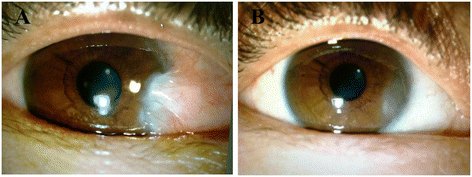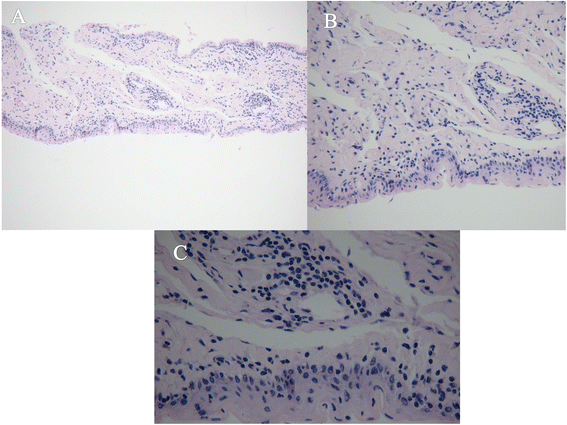Simultaneous treatment of pterygium complicated with conjunctivochalasis: analysis of pterygium excision and conjunctival autotransplantation combined with sclera fixation
- PMID: 26265227
- PMCID: PMC4533795
- DOI: 10.1186/s12886-015-0057-4
Simultaneous treatment of pterygium complicated with conjunctivochalasis: analysis of pterygium excision and conjunctival autotransplantation combined with sclera fixation
Abstract
Background: This prospective study investigated the safety and efficacy of a therapeutic method of treating pterygium complicated with conjunctivochalasis, using pterygium excision and conjunctival autotransplantation combined with sclera fixation, followed by therapeutic contact lens application.
Methods: Fifty-seven patients (83 eyes) diagnosed as pterygium complicated with conjunctivochalasis, at our hospital from July 2011 to June 2012, were selected. Patients were treated with pterygium excision and conjunctival autotransplantation combined with sclera fixation surgery, then therapeutic bandage contact lenses were applied. The efficacy of simultaneous surgery was evaluated based on vision changes, tear dynamics, and other complications. Histopathological changes were investigated on removed bulbar conjunctival tissue, using hematoxylin eosin (HE) and Masson's trichrome staining.
Results: (1) Three months after the operation, the success of simultaneous surgery in the treatment of pterygium was 97.6 %, and the recurrence was 2.4 %. Based on subjective evaluation, the success of the simultaneous treatment of conjunctivochalasis was 95.2 %, and failure was 4.8 %. Based on objective evaluation, the success rate was 94.0 % and the recurrence rate was 6.0 %. (2) Visual acuity of the 83 eyes was significantly improved after surgery, and was statistically significant (X 2 = 10.29, P < 0.05). (3) Three months after surgery, the height and integrity of the tear meniscus, tear film break-up time, and chloramphenicol test results of the 83 eyes were significantly improved and there was a statistically significant difference (X 2 the height and integrity of tear meniscus = 147.24, X 2 tear film break-up time = 81.17, X 2 chloramphenicol test = 17.41, P < 0.01). (4) Complications after the operation such as granulation hyperplasia, constrictive fornix, oculomotor defect, and other complications were not observed. (5) Pathological observations, using HE and Masson's trichrome staining of removed bulbar conjunctival tissue, showed several pathological changes, including obvious squamous epithelial hyperplasia, parakeratosis, basal cell pigmentation, lamina propria hemorrhage, infiltration of lymphocytes, and reduction of elastic fibers and collagen fibers.
Conclusion: Pterygium excision and conjunctival autotransplantation, combined with sclera fixation followed by therapeutic contact lens use was safe, effective, and suitable for simultaneous treatment of pterygium complicated with conjunctivochalasis.
Figures



Similar articles
-
The Effect of Conjunctival Flap Transplantation, Pterygium Excision, and Scleral Fixation Surgery in Treating Pterygium Combined with Conjunctival Laxity and Its Impact on Postoperative Complications.Altern Ther Health Med. 2024 Jun;30(6):188-195. Altern Ther Health Med. 2024. PMID: 37944957 Clinical Trial.
-
Simultaneous treatment of pterygium and temporal conjunctivochalasis.J Nippon Med Sch. 2013;80(1):74-7. doi: 10.1272/jnms.80.74. J Nippon Med Sch. 2013. PMID: 23470810
-
The treatment outcomes of crescent-shaped conjunctiva resection combined with conjunctiva sclera fixation for severe conjunctivochalasis.Eur Rev Med Pharmacol Sci. 2016 Jan;20(17):3519-22. Eur Rev Med Pharmacol Sci. 2016. PMID: 27649649
-
Options and adjuvants in surgery for pterygium: a report by the American Academy of Ophthalmology.Ophthalmology. 2013 Jan;120(1):201-8. doi: 10.1016/j.ophtha.2012.06.066. Epub 2012 Oct 11. Ophthalmology. 2013. PMID: 23062647 Review.
-
Surgery of the conjunctiva.Dev Ophthalmol. 2008;41:138-158. doi: 10.1159/000131086. Dev Ophthalmol. 2008. PMID: 18453766 Review.
Cited by
-
The role of elastic fibers in pathogenesis of conjunctivochalasis.Int J Ophthalmol. 2017 Sep 18;10(9):1465-1473. doi: 10.18240/ijo.2017.09.21. eCollection 2017. Int J Ophthalmol. 2017. PMID: 28944209 Free PMC article. Review.
-
Therapeutic contact lenses vs. tight bandage patching and pain following pterygium excision: a prospective randomized controlled study.Graefes Arch Clin Exp Ophthalmol. 2018 Nov;256(11):2143-2148. doi: 10.1007/s00417-018-4118-2. Epub 2018 Sep 1. Graefes Arch Clin Exp Ophthalmol. 2018. PMID: 30173337 Clinical Trial.
-
Comparison of Samfilcon A and Balafilcon A Bandage Contact Lenses in Reducing Postoperative Symptoms After Pterygium Surgery.Clin Optom (Auckl). 2024 Nov 12;16:287-292. doi: 10.2147/OPTO.S490602. eCollection 2024. Clin Optom (Auckl). 2024. PMID: 39554596 Free PMC article.
-
Dust exposure: a novel environmental risk factor for conjunctivochalasis?Ther Adv Ophthalmol. 2021 Jun 30;13:25158414211027757. doi: 10.1177/25158414211027757. eCollection 2021 Jan-Dec. Ther Adv Ophthalmol. 2021. PMID: 34263137 Free PMC article.
-
A preliminary study on the establishment of an animal model of conjunctivochalasis.Int J Ophthalmol. 2018 Jun 18;11(6):899-904. doi: 10.18240/ijo.2018.06.01. eCollection 2018. Int J Ophthalmol. 2018. PMID: 29977798 Free PMC article.
References
-
- Nolan TM, DiGirolamo N, Sachdev NH, Hampartzoumian T, Coroneo MT, Wakefield D. The role of ultraviolet irradiation and heparin-binding epidermal growth factor-like growth factor in the pathogenesis of pterygium. Am J Pathol. 2003;162(2):567–74. doi: 10.1016/S0002-9440(10)63850-3. - DOI - PMC - PubMed
Publication types
MeSH terms
LinkOut - more resources
Full Text Sources
Other Literature Sources

